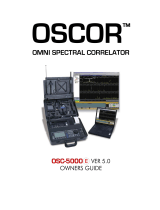
Whitepaper: Spread Spectrum Time-Domain Reectometry www.T3Innovation.com
IEEE SENSORS JOURNAL, VOL. 5, NO. 6, DECEMBER 2005 1469
Analysis of Spread Spectrum Time Domain
Reflectometry for Wire Fault Location
Paul Smith, Member, IEEE, Cynthia Furse, Senior Member, IEEE, and Jacob Gunther, Member, IEEE
Abstract—Spread spectrum time domain reflectometry (SSTDR)
and sequence time domain reflectometry have been demonstrated
to be effective technologies for locating intermittent faults on air-
craft wires carrying typical signals in flight. This paper examines
the parameters that control the accuracy, latency, and signal to
noise ratio for these methods. Both test methods are shown to be
effective for wires carrying ACpower signals, and SSTDR is shown
to be particularly effective at testing wires carrying digital sig-
nals such as Mil-Std 1553 data. Results are demonstrated for both
controlled and uncontrolled impedance cables. The low test signal
levels and high noise immunity of these test methods make them
well suited to test for intermittent wiring failures such as open cir-
cuits, short circuits, and arcs on cables in aircraft in flight.
Index Terms—Aging wire detection, arc detection, sequence time
domain reflectometry (STDR), spread spectrum time domain re-
flectometry (SSTDR), time domain reflectometry (TDR), wire fault
detection.
I. INTRODUCTION
F
OR MANY years, wiring has been treated as a system that
could be installed and expected to work for the life of an
aircraft [1]. As aircraft age far beyond their original expected
life span, this attitude is rapidly changing. Aircraft wiring prob-
lems have recently been identified as the likely cause of several
tragic mishaps [2] and hundreds of thousands of lost mission
hours [3]. Modern commercial aircraft typically have more than
100 km of wire [2]. Much of this wire is routed behind panels or
wrapped in special protective jackets, and is not accessible even
during heavy maintenance when most of the panels are removed.
Among the most difficult wiring problems to resolve are those
that involve intermittent faults [4]. Vibration that causes wires
with breached insulation to touch each other or the airframe,
pins, splices, or corroded connections to pull loose, or “wet
arc faults” where water drips on wires with breached insulation
causing intermittent line loads. Once on the ground these faults
Manuscript received April 10, 2004; revised September 14, 2004. This work
was supported in part by the Utah Center of Excellence for Smart Sensors and in
part by the National Science Foundation under Contract 0097490. The associate
editor coordinating the review of this paper and approving it for publication was
Prof. Michael Pishko.
P. Smith is with VP Technology, LiveWire Test Labs., Inc., Salt Lake City,
UT 84117 USA (e-mail: psmith@livewiretest.com).
C. Furse is with the Department of Electrical and Computer Engineering, Uni-
versity of Utah, Salt Lake City, UT 84112 USA, and also with VP Technology,
LiveWire Test Labs., Inc., Salt Lake City, UT 84117 USA (e-mail: cfurse@
ece.utah.edu).
J. Gunther is with the Department of Electrical and Computer Engineering,
edu).
Digital Object Identifier 10.1109/JSEN.2005.858964
often cannot be replicated or located. During the few millisec-
onds it is active, the intermittent fault is a significant impedance
mismatch that can be detected, rather than the tiny mismatch
observed when it is inactive. A wire testing method that could
test the wires continually, including while the plane is in flight
would, therefore, have a tremendous advantage over conven-
tional static test methods.
Another important reason to test wires that are live and in
flight is to enable arc fault circuit breaker technology [5] that is
being developed to reduce the danger of fire due to intermittent
short circuits. Unlike traditional thermal circuit breakers, these
new circuit breakers trip on noise caused by arcs rather than re-
quiring large currents. The problem is that locating the tiny fault
after the breaker has tripped is extremely difficult, perhaps im-
possible. Locating the fault before the breaker trips could enable
maintenance action.
This paper describes and analyzes one such method, based
on spread spectrum communication techniques that can do just
that. This method is accurate to within a few centimeters for
wires carrying 400-Hz aircraft signals as well as MilStd 1553
data bus signals. Results are presented on both controlled and
uncontrolled impedance cables up to 23 m long.
Early research on spread spectrum time domain reflectometry
(SSTDR) [6] has considered fault location tests on high voltage
power wires. Sequence time domain reflectometry (STDR) [7]
has been studied and used to test twisted pairs for use in commu-
nications. More recently, it has been demonstrated for location
of intermittent faults such as those on aircraft wiring [18]. These
test methods could be used as part of a smart wiring system
[2], and could provide continuous testing of wires on aircraft
in flight, with automatic reporting of fault locations to facilitate
quick wiring repairs. This could be done by integrating the elec-
tronics into either the circuit breaker or into “connector savers”
throughout the system. In order for this to be feasible, the pro-
totype system that has been described here is being redesigned
as a custom ASIC, which should cost on the order of $10–$20
per unit in bulk. This paper focuses on the analysis of SSTDR
and STDR. Parameters required for these methods to function
as potential test methods on wires carrying 400-Hz ACor high
speed digital data such as Mil-Std 1553 are discussed. This anal-
ysis is critical to determine the system tradeoffs between speed,
accuracy, code length/system complexity, etc. This ideal anal-
ysis provides information on the expected accuracy, which is
verified with tests of near-ideal lossless controlled impedance
coax. The effect of realistic noncontrolled impedance cable is
also evaluated, and sources of error within a realistic system are
discussed.
1530-437X/$20.00 © 2005 IEEE












